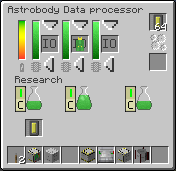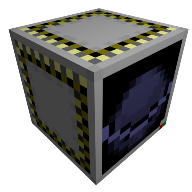Astrobody Data Processor
Overview

The Astrobody Data Processor is essentially a computer that analyses data brought in from satellites and telescopes. The purpose of this machine is to process data and program the analysed data into asteroid ID chips for use with asteroid mining missions.
The Astrobody Data Processor can handle the three main data types and the data can either be loaded from a data storage unit or from wireless transceivers.
The Astrobody Data processor is also responsible for completing the asteroid ID chips.
Usage
Programming asteroid ID Chips
The AstroBody Data Processor finishes up chips that have had an asteroid loaded onto them in an observatory. It takes 1000 of each of the three data types to fully complete an asteroid chip, which is always desireable because anything lower than 1000 can adversely affect the output of the mining mission.The input slot in the bottom left holds the asteroid ID chip to store data to. The Astrobody Data Processor has three data buffers, one for Mass data, one for Distance Data, and one for Composition data. Toggling the switches enables/disables programming of each data type.
Because the Astrobody Data Processor is relatively slow and cannot be sped up with coils or motors, it is recommended to have multiple going at once if you plan to launch many asteroid mining missions, as data collection can vastly outpace a single Astrobody Data Processor


